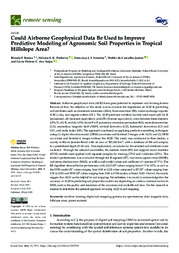Could airborne geophysical data be used to improve predictive modeling of agronomic soil properties in tropical hillslope area?
Could airborne geophysical data be used to improve predictive modeling of agronomic soil properties in tropical hillslope area?
Autoria: BASTOS, B. P.; PINHEIRO, H. S. K.; FERREIRA, F. J. F.; CARVALHO JUNIOR, W. de; ANJOS, L. H. C. dos
Resumo: Airborne geophysical data (AGD) have great potential to represent soil-forming factors. Because of that, the objective of this study was to evaluate the importance of AGD in predicting soil attributes such as aluminum saturation (ASat), base saturation (BS), cation exchange capacity (CEC), clay, and organic carbon (OC). The AGD predictor variables include total count (uR/h), K (potassium), eU (uranium equivalent), and eTh (thorium equivalent), ratios between these elements (eTh/K, eU/K, and eU/eTh), factor F or F-parameter, anomalous potassium (Kd), anomalous uranium (Ud), anomalous magnetic field (AMF), vertical derivative (GZ), horizontal derivatives (GX and GY), and mafic index (MI). The approach was based on applying predictive modeling techniques using (1) digital elevation model (DEM) covariates and Sentinel-2 images with AGD; and (2) DEM covariates and Sentinel-2 images without the AGD. The study was conducted in Bom Jardim, a county in Rio de Janeiro-Brazil with an area of 382,430 km², with a database of 208 soil samples to a predefined depth (0-30 cm). Non-explanatory covariates for the selected soil attributes were excluded. Through the selected covariables, the random forest (RF) and support vector machine (SVM) models were applied with separate samples for training (75%) and validation (25%). The model's performance was evaluated through the R-squared (R2), root mean square error (RMSE), and mean absolute error (MAE), as well as null model values and coefficient of variation (CV%). The RF algorithm showed better performance with AGD (R2 values ranging from 0.15 to 0.23), as well as the SVM model (R2 values ranging from 0.08 to 0.23) when compared to RF (R2 values ranging from 0.10 to 0.20) and SVM (R2 values ranging from 0.04 to 0.10) models without AGD. Overall, the results suggest that AGD can be helpful for soil mapping. Nevertheless, it is crucial to acknowledge that the accuracy of AGD in predicting soil properties could vary depending on various common factors in DSM, such as the quality and resolution of the covariates and available soil data. Further research is needed to determine the optimal approach for using AGD in soil mapping.
Ano de publicação: 2023
Tipo de publicação: Artigo de periódico
Unidade: Embrapa Solos
Observações
1 - Por padrão são exibidas publicações dos últimos 20 anos. Para encontrar publicações mais antigas, configure o filtro ano de publicação, colocando o ano a partir do qual você deseja encontrar publicações. O filtro está na coluna da esquerda na busca acima.
2 - Para ler algumas publicações da Embrapa (apenas as que estão em formato ePub), é necessário ter, no celular ou computador, um desses softwares gratuitos. Sistemas Android: Google Play Livros; IOS: iBooks; Windows e Linux: software Calibre.
Acesse outras publicações
Acesse a Base de Dados da Pesquisa Agropecuária (BDPA) para consultar o acervo completo das bibliotecas da Embrapa.

